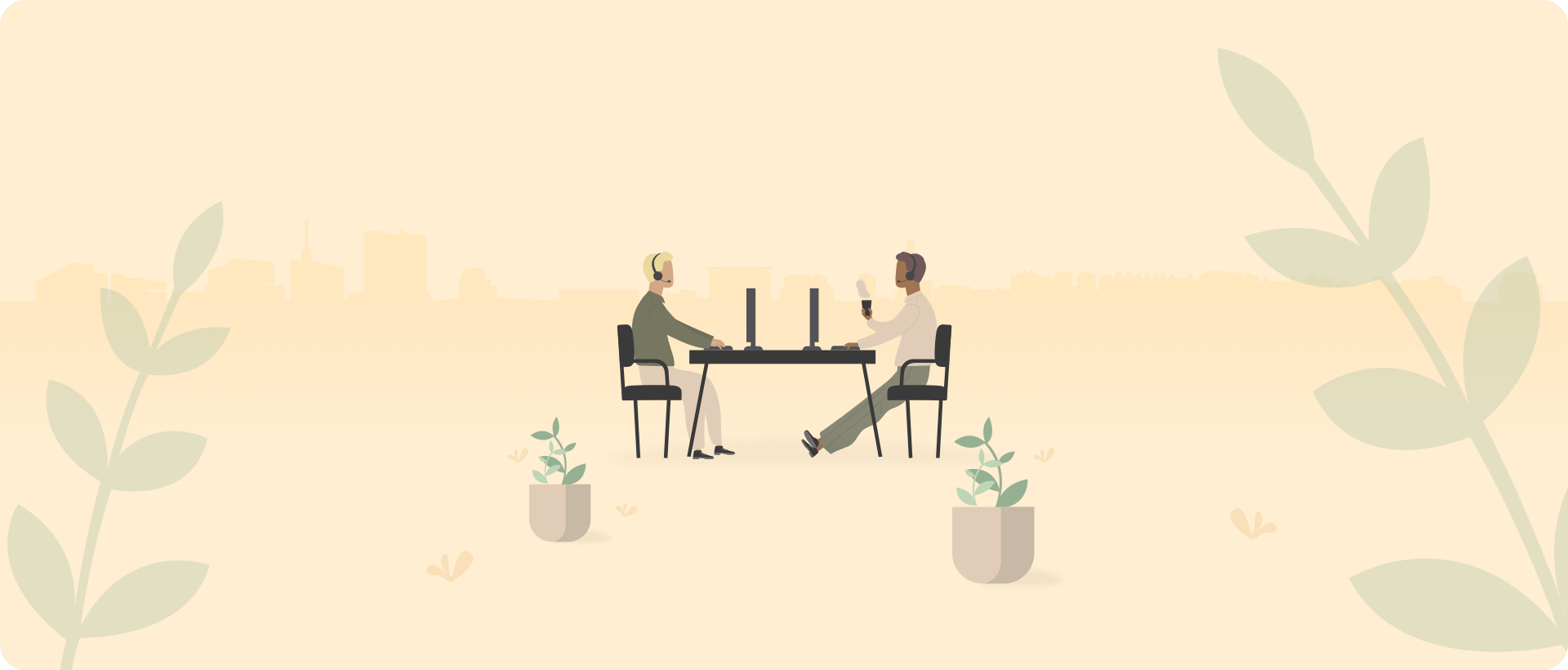Employee attrition has long been thought of as a necessary evil for call centers and BPOs, due to the nature of the chat agent role – entry-level, with limited requirements – and the average profile of the applicant pool.
But when it costs you on average $7500 to train a new agent and takes upwards of six weeks to properly onboard a new hire, it’s not just necessary but mandatory to tackle this challenge. The average call center attrition rate in the US has reached 30-45%, which is over 3X the US all-industry average.
Even for the smaller contact centers and BPOs, this still means huge operating losses; the empty seats need to be refilled, so new candidates need to be screened, selected, and interviewed. Your recruiting team needs to go through the full process again while knowing that the new joiners – even the ones who seem to be a good fit – might leave the company in just a few weeks.
When you’re hiring 100 employees per month, a 30% attrition rate may not seem like a huge problem; but when you’re an industry leader or you’re looking to scale your operations and catch up with the competition, you’re dealing with yearly candidate volumes of 500k and even more.
At this level, losing a third of your call agents every month is a burning problem that needs to be tackled and solved immediately. And while your managers are busy recruiting new agents, the pressure on your current employees continues to increase, just like the demand for high-quality customer service is continuing to grow.
You can’t afford to lose or hire the wrong talent if you want your business to succeed. But where do you start fixing this, how do you decrease call center attrition in a way that’s sustainable and scalable? By addressing its root cause!
What’s in?
Like what you see?
Don’t miss out. Subscribe to our quarterly digest to get the latest TA and TM resources delivered right to your inbox.
The biggest contributing factor to call center attrition
There are a number of factors that could cause an employee to attrit: misaligned expectations, low employee engagement, poor onboarding or training can all impact your involuntary and voluntary attrition rates.
Attrition is, therefore, a multivariate problem, but what all these causes of call center attrition have in common is that they begin with recruitment.
During recruitment, your hiring team is tasked with sourcing, selecting, engaging, and ultimately hiring the best candidate for the role. At scale, when hiring hundreds or even thousands of call center agents, nailing each part of the hiring process can be a challenge. In 2021, as unemployment remains high and candidates are coming in higher numbers than ever, especially for work-from-home roles, volume hiring is even more difficult.
No matter the reason for attrition, whether it be because of performance or because the candidate doesn’t like the role, it all comes down to a mismatch between your organization and the candidate.
Whether it be a hire whose skills aren’t fit for the job or a candidate who didn’t expect to handle angry customers on the phone and quits, the attrition you have control over begins with your selection process.
It might feel natural to look for difficulties with the job itself — like repetitive work, low mobility, or even a lack of recognition as the culprit. While these factors always play a part in attrition if they aren’t addressed, the truth is that a bulk of call center attrition occurs between 30 and 90-days. This means many candidates aren’t even staying around long enough to notice those challenges.
So, while you should always prioritize your employee satisfaction and engagement, it means you need to start with finding the right hires to satisfy and engage. And, those hires need to be informed of the realities of the job before they’re even hired.
- White paper
Before you continue!
Don’t forget to grab your free copy of our white paper on contact center volume hiring in 2021. Learn about:
- The challenges currently shaping the contact e
center recruitment space - How employers can navigate the new remote-first reality, and the role of technology in a future-proof recruitment process
- The four building blocks of a fully digital recruitment process

How do you decrease call center attrition?
As we’ve covered, it all begins with recruitment. If you’d like to dive more deeply into the root causes of voluntary attrition, have a look at our guide to leading causes of attrition at call centers and BPOs. Once you’ve got a grasp on the root causes of attrition, the solution lies in improving your recruitment process.
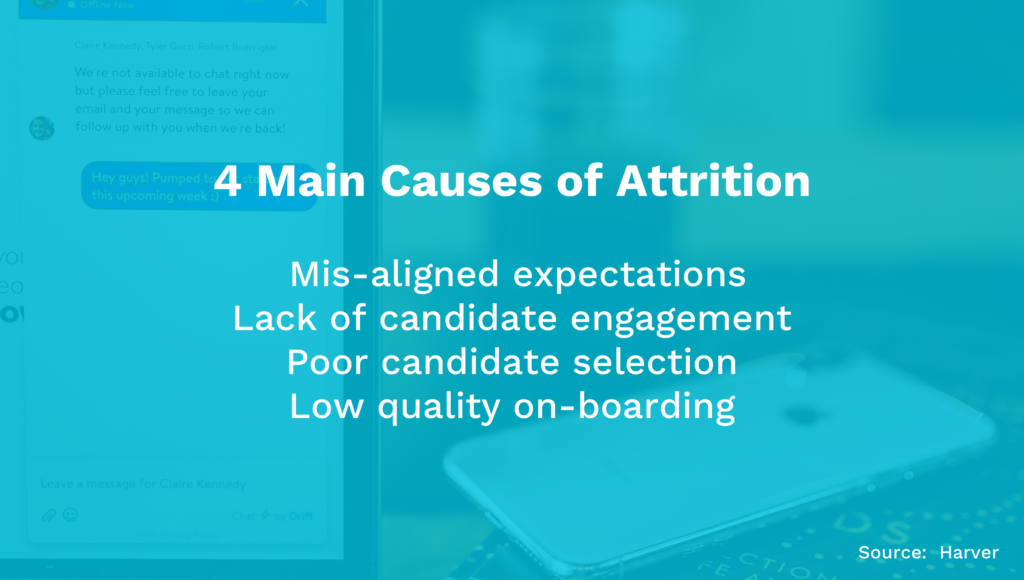
The first step is to determine why your employees are most likely to attrit. If your candidates are leaving as soon as they experience the job for the first time, you’re likely suffering from mismanaged expectations.
If candidates are leaving involuntarily (being let go because of misconduct or poor performance), you will need to take a hard look at your candidate selection. If you begin with high-quality candidates but feel like they never make it to the hiring stage, candidate engagement might be your top priority.
However, at scale, when hiring thousands of candidates, it is rarely this cut and dry. The truth is that for most organizations, every cause of attrition will play a factor. That’s why it’s absolutely critical to look at your process holistically, rather than trying to put out one fire at a time.
With that covered, let’s dive into how you can transform your process to combat no-show rates, early, and longer-term attrition.
1. Use a realistic job preview (RJP)
We work with contact centers and BPOs around the world, and the cause of attrition we see most commonly is misaligned expectations.
Often, candidates are selected and hired quickly from a pool of thousands, or tens of thousands of applicants. During the hiring process, they don’t get adequate information to experience the job and decide if it’s right for them. It’s easy to shy away from giving candidates an opportunity to opt-out of a role, but as losing even one agent is extremely costly, it’s better to lose an applicant than a new hire.
The best way to combat misaligned expectations is to give the candidate an opportunity to experience the job through a realistic job preview, sometimes called a job simulation.
A realistic job preview allows the candidate to try the job first hand, and experience some of the critical situations they’d encounter day-to-day. While they see the reality of the role, your team can collect data on how they’d perform in a true-to-life scenario, to help improve your hiring decisions.
Realistic job previews come in a variety of formats (both interactive and not), including Situational Judgement Tests, Chat Support Simulations, or Employee Testimonials.
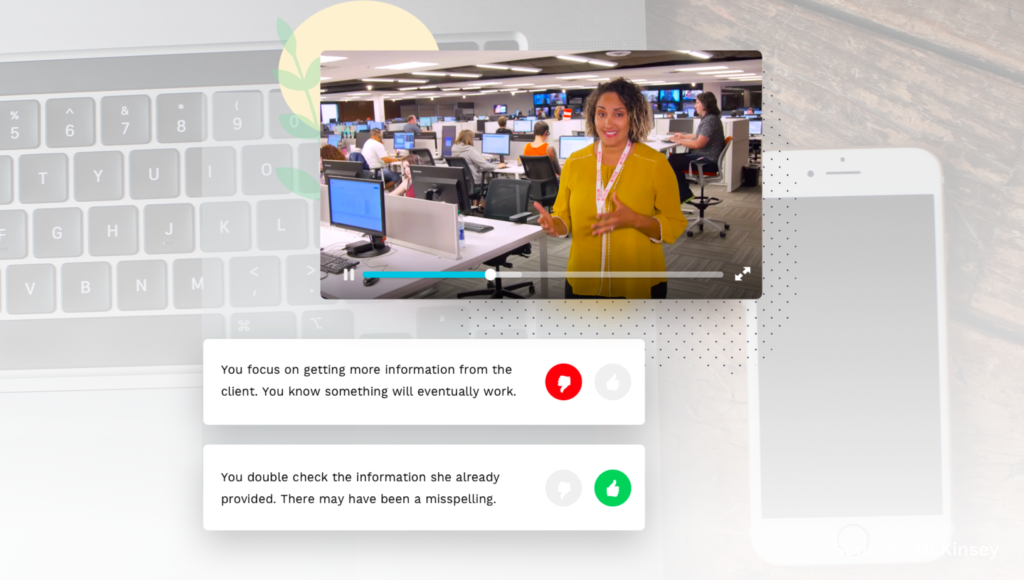
A situational judgment test is a behavioral assessment tool that allows you to gauge how a candidate would naturally react to a “critical situation,” such as an angry customer who missed their flight. It can provide valuable insight into a candidate’s fit for the role, and also inform them of challenges they might encounter, to avoid any surprises when they start.
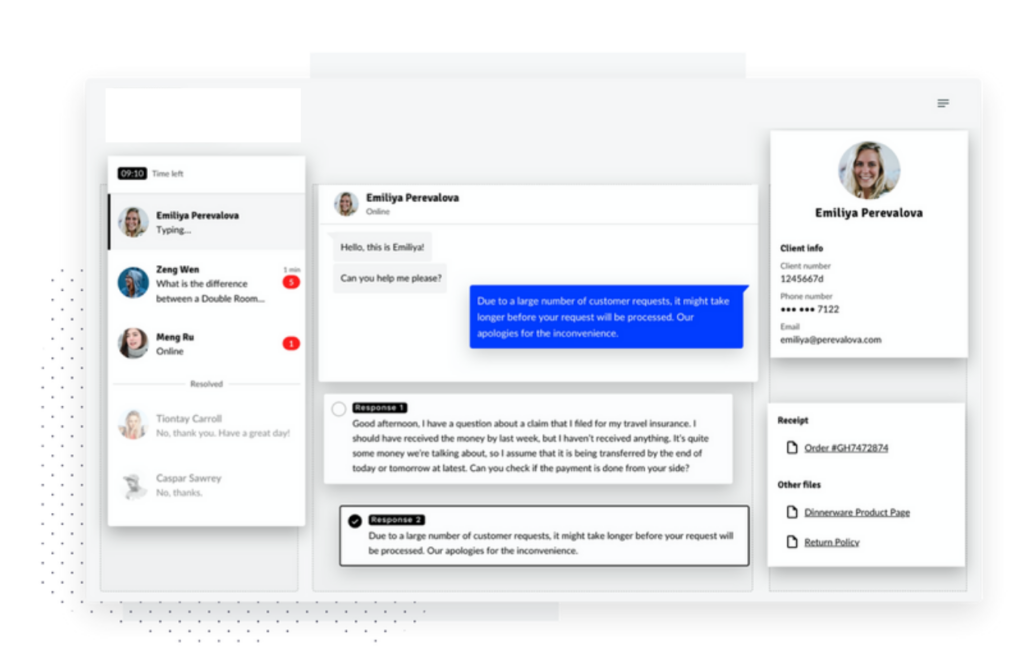
A job simulation, such as a live chat support simulation, is part situational judgment test part skills assessment. This way, you can see how a candidate applies their judgment while testing their ability to multitask, prioritize, and navigate basic software.
An employee testimonial, when embedded in the job application, won’t test an employee’s skills but can still assist with engaging and informing the candidate. It would be best paired with an interactive job preview so that you can collect data to drive hiring decisions.
Experience our best-in-class Live Chat Assessment first-hand!
Perfect for remote hiring, our live chat assessment makes it easier than ever to hire live chat agents. Candidates experience the job, while you get actionable data to drive hiring decisions.
2. Candidate self scheduling
Even with more candidates than ever on the market, there is still a war on talent. Whether you have 100 applicants, or 100,000, you’ll need to engage the best candidates quickly, or they’ll accept another offer — maybe even with your competitor. Candidate self-scheduling improves speed of hiring, and improving the speed of hiring means you can offer a role sooner.
When job hunting, most candidates are prepared for an impersonal application process. By making your process fast, interactive, and engaging, you differentiate yourself from other organizations and start the employee life cycle with a positive first impression.
Candidates are looking for a job, and in all likelihood, they’re looking to be hired quickly. This means once they apply if they’re a strong fit, they need to move through the process fast. If you have an engaging application process, it’s even more critical to contact them right away, so no momentum is lost.
This is why self-scheduling can be a strong competitive advantage. When a strong candidate scores well on the application process, you can allow them to self-schedule an interview while they’re feeling engaged and excited about your organization.
With a high-quality pre-selection process in place, top candidates will be automatically identified and invited to interview, or self-schedule an interview as soon as they hit apply. This drastically reduces drop-off at the top of the hiring funnel, improving the overall quality of your talent pool.
You can also leverage a chatbot, text scheduling, and email automation to inform candidates of their status and keep them “warm.” If your pre-selection process is strong enough, you could even automate the process completely from apply-to-hire, and offer candidates the opportunity to schedule their onboarding with little to no manual work.
Hire better live chat agents, at scale.
Dive into the rise of live chat, the skills of top-performing agents, and how to best assess them to reduce attrition and guarantee top-notch customer service.

3. Matching technology and call-type matching
Even if you have a class of new hires who are excited and engaged, you still need to ensure they’re the right fit for the role based on their skills and competencies. For entry level positions, resumes aren’t the best predictor of success. And, you don’t have time to manually sift through thousands, or tens of thousands, of resumes if you want to make hiring decisions quickly, at scale. Not to mention, resume review is very subjective, and can easily lead to poor selection and unconscious bias.
You need matching technology, specifically built for the contact center industry. Matching technology, in short, is a set of assessments that predict how likely a candidate is to succeed in a role. For contact centers, this means identifying candidates who will succeed in a contact center environment, and more specifically, what type of support they will be best at. Results should allow you to match the right job to the talent, rather than the other way around.
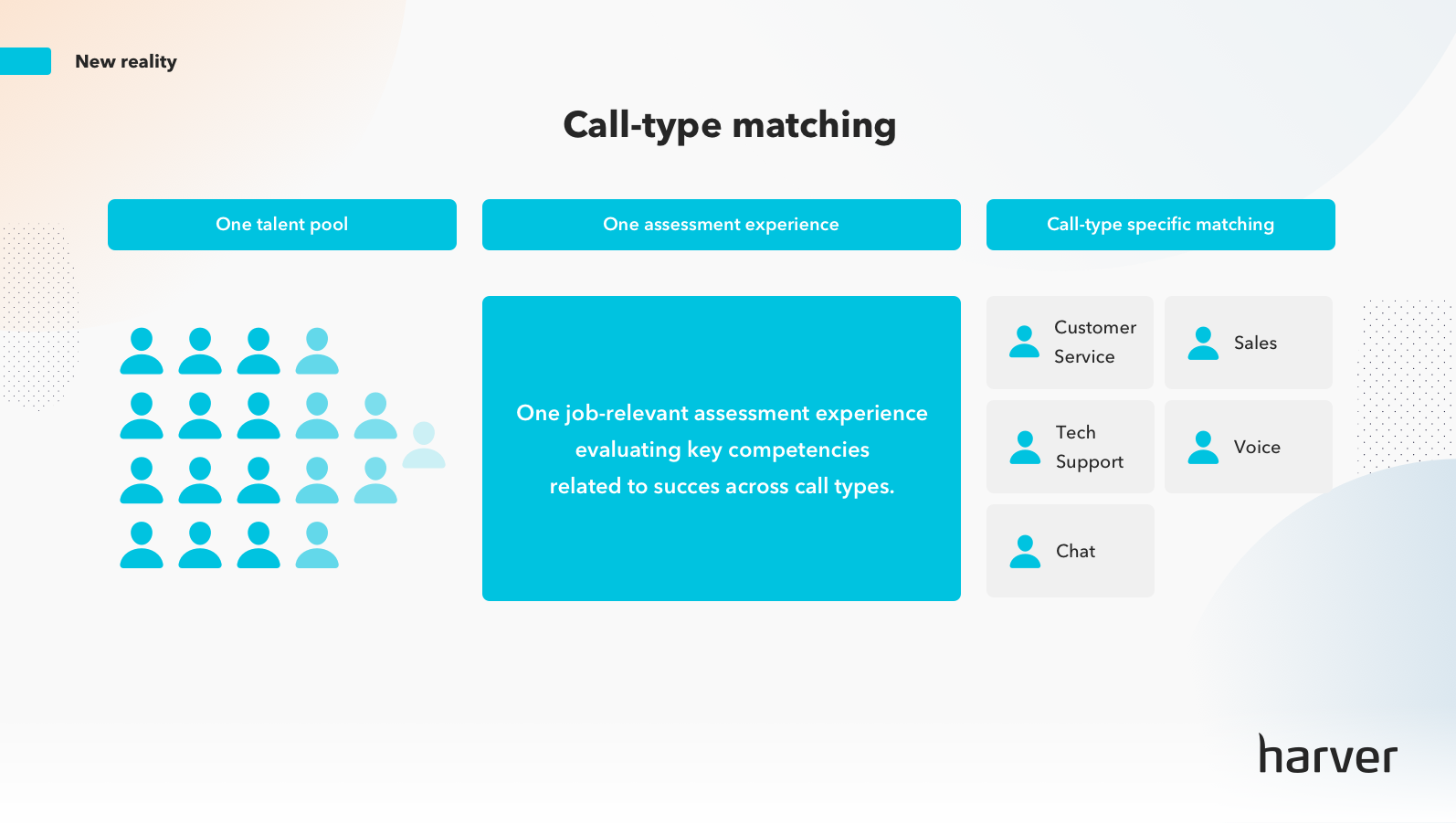
Harver’s Senior People Science Consultant, Linn Hadenius, says, “you have one talent pipeline, and one assessment experience – which should provide multiple scores across call types. This helps increase the likelihood that the right person is placed in the right role, without missing out on talent. For example, a candidate may show up for a sales position, but be a great fit for a technical support role without knowing it”.
To learn more about call-type matching, you can view the recording of our Contact Center Volume Hiring 2021 event.
4. Effective remote onboarding
On-boarding, the bridge between applicant and employee, has a direct effect on your attrition rates. At best, on-boarding connects your new-hire to the organization and leaves them feeling welcome and prepared to tackle the role. At worst, it causes frustration, resentment, and leaves a new-hire feeling confused and alienated. With nearly 90% of surveyed agents reporting they’d like to continue working remotely, it’s also important you can deliver an engaging on-boarding completely digitally.

A great on-boarding experience begins with great communication, and should tie in to your candidate self-scheduling and automated communications. Candidates should be consistently informed about the status of their documents, necessary training dates, and other important information. And, your communication during onboarding should also excite candidates about beginning their journey as an employee, and give them an opportunity to ask any questions they might have.
You may want to leverage a checklist to ensure you have everything covered, and ensure your candidate is informed of their onboarding plan. It’s also crucial that you check your applicants system set-up, either during the application process or during on-boarding, to make sure they are ready to go on their first day. Leverage this period of time to build their confidence, set expectations, and connect them to your team.
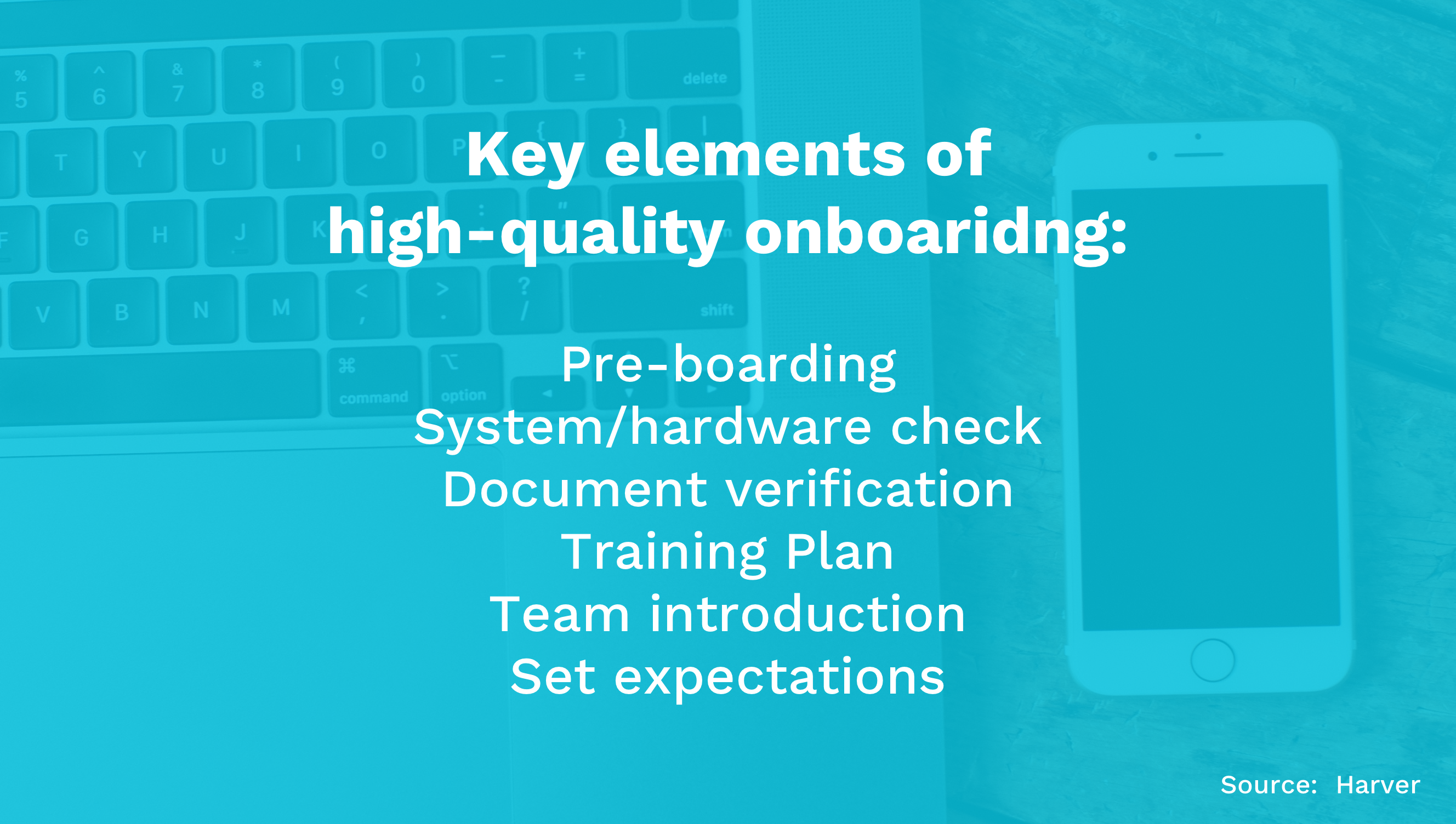
The result
When you’ve transformed your process to be engaging, fair and informative, the results are clear. Teams who have implemented these steps have seen a 35-70% decrease in attrition, combating the range of causes from mis-aligned expectations to poor selection.
What we’ve seen within our client base is that companies that transform their hiring process on these domains realize immediate, substantial attrition decreases.
One of the largest BPO providers in the world measured a 45% decrease in attrition after implementing a realistic job preview and scientifically validated matching technology. Another global client in the industry has been able to reduce attrition by up to 74% with call-type matching across their accounts.
Not only are they retaining more employees, but they’re also filling seats faster, reducing their recruitment costs, and winning more business through their ability to scale quickly. In a people-driven business, like customer experience, placing a firm focus on your people — finding them, hiring them, and retaining them, is a mission-critical endeavor.
Now, over to you
The first step in your journey is recognizing that attrition is a problem you can tackle, and not a simple reality of the industry. Attrition is only a necessary evil if you choose to live with it. However, industry leaders around the globe have risen to the challenge, and are finding themselves in a new reality of digital, efficient, and fair hiring.
We don’t just believe these problems have solutions — we know they do. And we’ve seen it with companies around the globe, which is why we create resources to help you tackle them.
Here, we’ve scratched the surface on the challenge of attrition and how you can solve it. If you’re ready to go to the next level, download our Contact Center Hiring White Paper, where we break down the major challenges of volume hiring, like attrition, and how to tackle them at scale.
- White paper
Before you continue!
Don’t forget to grab your free copy of our white paper on contact center volume hiring in 2021. Learn about:
- The challenges currently shaping the contact e
center recruitment space - How employers can navigate the new remote-first reality, and the role of technology in a future-proof recruitment process
- The four building blocks of a fully digital recruitment process

